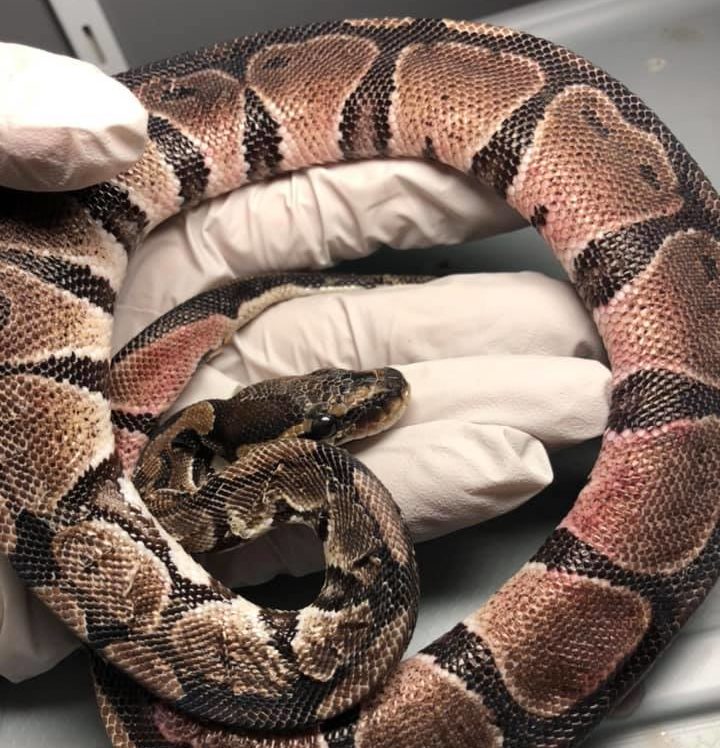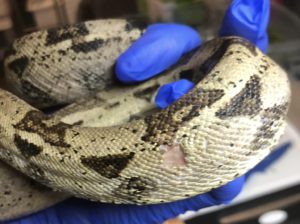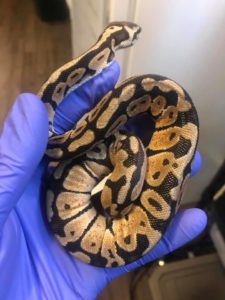
Vitamin C Deficiency in Snakes

A vitamin C deficiency, or hypovitaminosis C, is typically seen in malnourished snakes and a rare condition. In humans, this disorder is known as “scurvy” and can cause swollen and bleeding gums as well as bruising and skin discoloration. Hypovitaminosis C is not a common deficiency in snakes, but we have received several snakes with a presumed deficiency due to their history and symptoms. This is definitely a disorder that could benefit from additional research and study.
Causes
This disorder is almost exclusively found in malnourished snakes with a history of anorexia or hyporexia. We have had 4 cases of suspected hypovitaminosis C in snakes: 3 ball pythons (Python regius) and 1 common boa constrictor (Boa imperator). All had a history of chronic malnutrition, mostly from husbandry-induced anorexia. It is also theorized that feeder rodents who have not been fed a complete diet can also lead to hypovitaminosis C.
Vitamin C is produced in the kidneys and intestines, so it’s also theorized that kidney or intestinal disease may also lead to insufficient synthesis of this vitamin (Wissman, 2011). Vitamin C is also important for the production of collagen, which is important in maintaining the strength and elasticity of the skin (Wissman, 2011). This explains the friable skin that easily tears in these cases.
Symptoms

The primary symptoms we see are extremely thin skin and skin tears. The skin will appear almost translucent and the color will be slightly duller, and the skin is extremely prone to tearing from minimal handling. One of the snakes tore her skin open simply from being picked up to clean her cage. These tears are often large and can occur in multiple areas. So far, all of the tears we have noticed have been on the dorsal scales. We also notice subcutaneous edema (swelling with fluid under the skin), which was seen in 3 of the 4 cases–the boa constrictor did not have edema. The edema seems to vary based on shed cycles. When snakes are about to shed, they normally produce a fluid to go in between their old skin and new skin. Our theory is that the adhesion between the old and new layers is inadequate due to collagen insufficiency in snakes with hypovitaminosis C, resulting in fluid bubbles around the shed cycle. In the most severe case, the snake had constant edema regardless of where she was in her shed cycle. In this case, the fluid was also serosanguinous instead of clear, indicating blood and potentially infection.
Diagnostics

To our knowledge, there is no available blood test for plasma vitamin C levels in reptiles. Our veterinarians have treated symptomatically. There are no tested reference values on vitamin C in snakes. Therefore, these cases should be taken as anecdotal and theory-based only. However, ruling out sepsis and bacteremia is important for making this differential. If a bacterial culture comes back negative and the snake does not respond to antibiotics, hypovitaminosis C may be considered.
Treatment

Treatment should include nutritional support and vitamin supplementation immediately. We take these cases to our veterinarian for a multivitamin injection, which includes vitamin C. This may need to be repeated several more times. If the snake is eating on their own, then dust their prey with a reptile multivitamin supplement (such as Repashy Supervite) and continue feeding regular meals. It is advised to feed smaller than normal meals due to skin fragility, as larger meals could cause the skin to tear. If the snake is not eating on its own, assist feeding or tube feeding should be urgently considered. Handlers must be extremely careful when handling these snakes, and the smallest amount of restraint possible is advised to avoid damaging the skin. If the snake does have active skin tears and open wounds, we recommend bringing them to your veterinarian immediately. The wound should be cleaned and disinfected. Our veterinarians typically glue the skin shut with a skin-safe adhesive, as the skin is too thin to hold sutures. Your veterinarian may advise you to apply an antibiotic ointment topically or start the snake on antibiotics, depending on the general condition of the animal.
Be sure to provide correct husbandry as part of the healing process. Keep a sterile enclosure with paper towels to avoid getting any loose substrate into the wounds. We prefer bin, rack, or PVC enclosures for these snakes so we can keep a higher humidity to help with the skin. Use smooth plastic decor so that it cannot tear the skin.
Prognosis
Of our 4 suspected cases, 2 completely recovered, 1 is in the recovery process with a good prognosis, and 1 was humanely euthanized. If the condition is caught early enough, it can be reversed with nutritional support and the prognosis is good. However, complications may arise if the wounds become infected or the snake develops sepsis. In this case, prognosis is grave and humane euthanasia should be considered.
Prevention
The best way to prevent this is to feed your snakes an appropriate diet. They should always be fed whole prey from a good quality source. Snakes do not require additional supplemental vitamin C, as they can synthesize it from their meals. If your snake is not eating, monitor their condition and track their weight. This seems to be a condition that develops over several years of malnutrition, not from acute anorexia.
Specific Cases

Arabella: This young ball python was probably our most mild case. Her skin was slightly translucent and she had some subcutaneous edema, but the case was minor. Arabella’s previous owner reported anorexia. Arabella started eating on her own with us immediately. We provided her with an oral multivitamin solution and offered weekly meals. She shed normally, ate consistently, and was completely normal and adopted within 3 months.
Olive: This 5 year old boa constrictor was surrendered extremely emaciated and stunted. She was about the length of a normal 12-18 month old boa constrictor but much thinner. Olive’s owner reported chronic hyporexia (she hadn’t been eating consistently for years) and chronic dysecdysis (shedding issues). Olive had been kept in a very low-humidity enclosure, which is not appropriate for her species. Upon intake, we noticed several large scars and several open wounds. She was also extremely lethargic and weak. We disinfected the wounds, applied silver sulfadiazine cream, and brought her to our veterinarian. Our vet prescribed antibiotics to prevent infection and anti-inflammatories for pain, and she glued the large skin wounds shut. We gave her betadine baths and reapplied SSD cream to any wound areas until her next shed. Olive was most likely in pain during her first few weeks–she was extremely sensitive to touch and attempted to bite when picked up or touched. Olive never developed edema and made an incredible recovery. She ate by herself and shed normally. Olive quickly gained weight and her skin condition improved. Her behavior changed as well and she became a very docile, friendly snake. Olive was recovered and adopted out within 4 months.

Cygnus: This juvenile ball python is still in treatment but has been recovering well. His history is unclear but the family that owned him was terrified of him after their son left him when he went to college. It sounded like they did not care for Cygnus at all for several months, and his scarring and poor condition indicates poor care before this period. Upon intake, Cygnus was emaciated with several large scars and open wounds. His recovery has not been linear–Cygnus did see our vet for a vitamin injection and he has been eating by himself very well, but he had several poor sheds and tore his skin when being transferred to a new cage. Cygnus does have subcutaneous edema that seems to be at its worst when he is about ready to shed. Overall, he has gained a significant amount of weight and his wounds are healing well, but he is not quite recovered.
Lavender: Our most severe case was Lavender, a ball python who was removed from a neglect situation. According to the person who transported, her owners only fed her a small mouse once a month and her owners did not clean her cage or provide heat. Lavender was emaciated with retained shed upon intake. She had translucent skin and moderate subcutaneous edema. Her skin tore when being soaked or handled. Lavender saw our veterinarian for multivitamin injections, antibiotics, anti-inflammatory medications, and fluids. Over several weeks of treatment, Lavender’s condition worsened. Her edema became severe and spanned about half of her entire body, and would often leak out of areas where she got her injections. Her skin turned reddish and our vet suspects she developed a secondary bacterial infection and sepsis, likely from the dirty conditions she was kept in. Lavender did eat by herself but was eventually humanely euthanized by our veterinarian due to her poor condition.
References
Wissman, M. (2011, December). Snake skin peel and vitamin C deficiency. Reptiles, https://reptilesmagazine.com/snake-skin-peel-and-vitamin-c-deficiency/#:~:text=Sudden%20skin%20rupturing%20or%20spontaneous,signs%20of%20vitamin%20C%20deficiency..
